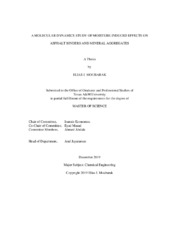| dc.description.abstract | The moisture effect on the work of adhesion of asphalt binder and mineral aggregates was investigated using molecular dynamic simulation. The implemented asphalt model, based on the OPLS-AA force field, was validated in terms of thermodynamic properties such as density and elastic properties (Young’s modulus and Poisson’s ratio). The density was about 2% below the experimental value of 1,005 kg/m^3 at ambient temperature. Two methods were used to obtain the Young’s modulus: the Theodorou and Suter method and the stress-strain method. The latter one was successful in predicting a Young’s modulus that is compatible with the values measured at the nanoscale (1,384 ± 595 MPa) using the Atomic Force Microscope and a Poisson’s ratio of 0.4. The Theodorou and Suter method did not yield the same success. Simulation successfully demonstrated the effect of temperature on the Young’s modulus, which decreased from 1,505 MPa to 1,024 MPa when temperature changed from 25 to 75°C. The Poisson’s ratio was found to be constant at all temperatures.
Two mineral structures were constructed in this work, the {101̅4} calcite and the {001} α-quartz represented by an optimized force field and CLAYFF, respectively. Calculations were successful in predicting that at 25, 50 and 75C and at a dry basis, the developed asphalt binder has a higher affinity to bond with calcite than quartz. It was also found that the work of adhesion for both structures was not affected by temperature. In addition, the Lennard-Jones interactions mostly contributed to the work of adhesion (80%). Calcite’s work of adhesion decreased by around 41% after adding water compared to a decrease of 21% for the case of adding water to quartz, which makes the former more susceptible to moisture damage. However, the asphalt still favored the calcite surface over quartz, which is evident by comparing the absolute values of the work of adhesion. Therefore, it is expected that the damage will start at the quartz surface before it does in the calcite surface. | en |


